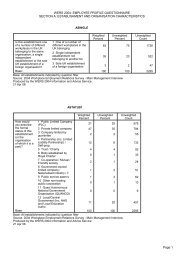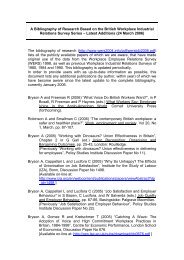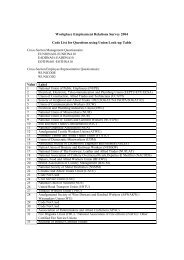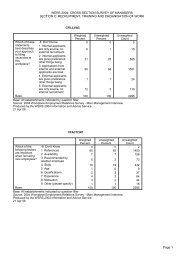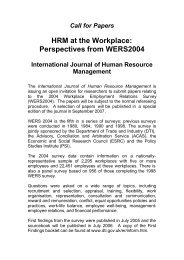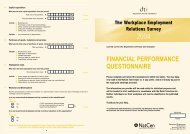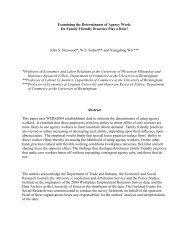A multilevel analysis of job satisfaction in Britain - WERS 2004
A multilevel analysis of job satisfaction in Britain - WERS 2004
A multilevel analysis of job satisfaction in Britain - WERS 2004
Create successful ePaper yourself
Turn your PDF publications into a flip-book with our unique Google optimized e-Paper software.
m<strong>in</strong>ority co-workers affects the <strong>job</strong> <strong>satisfaction</strong> <strong>of</strong> whites adversely but that suchan effect vanishes once they control for the characteristics <strong>of</strong> <strong>job</strong>s.3. The data and sampleThe data used <strong>in</strong> this study come from the <strong>2004</strong> British Workplace employmentrelations Survey, <strong>WERS</strong> <strong>2004</strong> (Department <strong>of</strong> Trade and Industry, 2005). It is themost recent survey <strong>in</strong> a series <strong>of</strong> five surveys <strong>of</strong> its k<strong>in</strong>d. 6 The survey is regardedas one <strong>of</strong> the most authoritative sources <strong>of</strong> <strong>in</strong>formation on employment relations<strong>in</strong> Great Brita<strong>in</strong>. It <strong>of</strong>fers l<strong>in</strong>ked employer-employee data drawn from apopulation <strong>of</strong> 700,000 workplaces (33 per cent <strong>of</strong> all workplaces <strong>in</strong> Brita<strong>in</strong>) and22.5 million employees (89 per cent <strong>of</strong> all employees <strong>in</strong> employment) (Kersley etal. 2006). 7The sample <strong>of</strong> workplaces covered by the <strong>WERS</strong> <strong>2004</strong> survey is a randomsample <strong>of</strong> the 33 per cent <strong>of</strong> all workplaces <strong>in</strong> Brita<strong>in</strong> stratified by workplace sizeand <strong>in</strong>dustry, with over-representation <strong>of</strong> large workplaces to make statisticallyreliable comparisons with their smaller counterparts. The probability <strong>of</strong> selection<strong>of</strong> an employee <strong>in</strong> the survey is a product <strong>of</strong> the probability <strong>of</strong> the employee’sworkplace be<strong>in</strong>g selected and the probability <strong>of</strong> selection <strong>of</strong> the employee. Thisweight has been used <strong>in</strong> the empirical <strong>analysis</strong> <strong>in</strong> this study, to be able toextrapolate the f<strong>in</strong>d<strong>in</strong>gs to the population <strong>of</strong> workplaces <strong>in</strong> Brita<strong>in</strong> with at leastfive employees (Kersley et al. 2006, Bryson et al. <strong>2004</strong>).The <strong>WERS</strong> <strong>2004</strong> survey has covered a whole host <strong>of</strong> issues relat<strong>in</strong>g to bothemployers and employees, thereby allow<strong>in</strong>g the <strong>in</strong>clusion <strong>of</strong> an array <strong>of</strong><strong>in</strong>dividual and workplace level attributes <strong>in</strong>to the <strong>analysis</strong> undertaken <strong>in</strong> thisstudy. The estimation sub-sample used <strong>in</strong> this study comprises <strong>of</strong> 20,692employees <strong>in</strong> some 1727 workplaces with complete <strong>in</strong>formation on all thevariables <strong>of</strong> <strong>in</strong>terest that are summarised <strong>in</strong> Table A3 <strong>in</strong> the Appendix.The <strong>WERS</strong> <strong>2004</strong> survey asked each employee to rate, on a five-po<strong>in</strong>t scale from‘very satisfied’ to ‘very dissatisfied’, regard<strong>in</strong>g how satisfied they were on eightaspects <strong>of</strong> their <strong>job</strong> <strong>in</strong>clud<strong>in</strong>g: (i) the sense <strong>of</strong> achievement they get from theirwork; (ii) the scope for us<strong>in</strong>g their own <strong>in</strong>itiative; (iii) the amount <strong>of</strong> <strong>in</strong>fluencethey have over their <strong>job</strong>; (iv) the tra<strong>in</strong><strong>in</strong>g they receive; (v) the amount <strong>of</strong> pay theyreceive; (vi) their <strong>job</strong> security; (vii) their <strong>in</strong>volvement <strong>in</strong> decision mak<strong>in</strong>g; and(viii) their work itself. An overall <strong>job</strong> <strong>satisfaction</strong> <strong>in</strong>dicator has been generatedfrom these eight facets <strong>of</strong> <strong>job</strong> <strong>satisfaction</strong> <strong>in</strong> a way similar to that <strong>of</strong> Bryson et al.(<strong>2004</strong>). 8 For the purpose <strong>of</strong> the empirical <strong>analysis</strong> undertaken, the ord<strong>in</strong>al<strong>in</strong>ter-group <strong>in</strong>teraction exists between m<strong>in</strong>orities and, <strong>in</strong> this case, whites; thereby impact<strong>in</strong>g<strong>in</strong>dividual <strong>job</strong> attitudes.6 Innovations <strong>in</strong> the most recent survey (<strong>WERS</strong> <strong>2004</strong>) <strong>in</strong>clude, among others, the <strong>in</strong>clusion <strong>of</strong>smaller firms with between five and n<strong>in</strong>e employees and the sampl<strong>in</strong>g <strong>of</strong> greater numbers <strong>of</strong> nonunionemployee representatives(Kersley et al. 2006).7 The survey population was all British workplaces but those <strong>in</strong> Agriculture, hunt<strong>in</strong>g & forestry,fish<strong>in</strong>g, m<strong>in</strong><strong>in</strong>g & quarry<strong>in</strong>g, private households with employed persons, extra-territorialorganizations and bodies compris<strong>in</strong>g <strong>of</strong> at least five employees (Kersley et al. 2006).8 Where a dummy variable equal to 1 if an employee was either ‘very satisfied’ or ‘satisfied’ and0 otherwise has been generated for each aspects <strong>of</strong> <strong>job</strong> <strong>satisfaction</strong> and eight such dummyvariables have been added to give an overall <strong>job</strong> <strong>satisfaction</strong> <strong>in</strong>dicator.6



